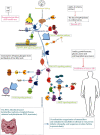The Health-Promoting Effects and the Mechanism of Intermittent Fasting
- PMID: 36911497
- PMCID: PMC10005873
- DOI: 10.1155/2023/4038546
The Health-Promoting Effects and the Mechanism of Intermittent Fasting
Abstract
Intermittent fasting (IF) is an eating pattern in which individuals go extended periods with little or no energy intake after consuming regular food in intervening periods. IF has several health-promoting effects. It can effectively reduce weight, fasting insulin levels, and blood glucose levels. It can also increase the antitumor activity of medicines and cause improvement in the case of neurological diseases, such as memory deficit, to achieve enhanced metabolic function and prolonged longevity. Additionally, IF activates several biological pathways to induce autophagy, encourages cell renewal, prevents cancer cells from multiplying and spreading, and delays senescence. However, IF has specific adverse effects and limitations when it comes to people of a particular age and gender. Hence, a more systematic study on the health-promoting effects and safety of IF is needed. This article reviewed the research on the health-promoting effects of IF, providing a theoretical basis, direction for subsequent basic research, and information related to the clinical application of IF.
Copyright © 2023 Simin Liu et al.
Conflict of interest statement
The authors have no conflicts of interest to declare.
Figures






Similar articles
-
The Role of Intermittent Fasting and Dieting on Cognition in Adult Population: A Systematic Review of the Randomized Controlled Trials.Med Princ Pract. 2023;32(2):99-109. doi: 10.1159/000530269. Epub 2023 Jun 1. Med Princ Pract. 2023. PMID: 37263255 Free PMC article.
-
Could Intermittent Energy Restriction and Intermittent Fasting Reduce Rates of Cancer in Obese, Overweight, and Normal-Weight Subjects? A Summary of Evidence.Adv Nutr. 2016 Jul 15;7(4):690-705. doi: 10.3945/an.115.011767. Print 2016 Jul. Adv Nutr. 2016. PMID: 27422504 Free PMC article. Review.
-
Effects and possible mechanisms of intermittent fasting on health and disease: a narrative review.Nutr Rev. 2023 Nov 10;81(12):1626-1635. doi: 10.1093/nutrit/nuad026. Nutr Rev. 2023. PMID: 36940184 Review.
-
Effects of intermittent fasting on glucose and lipid metabolism.Proc Nutr Soc. 2017 Aug;76(3):361-368. doi: 10.1017/S0029665116002986. Epub 2017 Jan 16. Proc Nutr Soc. 2017. PMID: 28091348 Review.
-
Unravelling the health effects of fasting: a long road from obesity treatment to healthy life span increase and improved cognition.Ann Med. 2020 Aug;52(5):147-161. doi: 10.1080/07853890.2020.1770849. Epub 2020 Jun 10. Ann Med. 2020. PMID: 32519900 Free PMC article. Review.
Cited by
-
Examining Associations Between Fasting Behavior, Orthorexia Nervosa, and Eating Disorders.Nutrients. 2024 Dec 11;16(24):4275. doi: 10.3390/nu16244275. Nutrients. 2024. PMID: 39770897 Free PMC article.
-
Promotion of Successful Weight Management in Overweight and Obese Veterans (POWER-VET): Trial Design and Methods.Contemp Clin Trials. 2024 Feb;137:107412. doi: 10.1016/j.cct.2023.107412. Epub 2023 Dec 16. Contemp Clin Trials. 2024. PMID: 38104857 Free PMC article. Clinical Trial.
-
Adipose tissue as a linchpin of organismal ageing.Nat Metab. 2024 May;6(5):793-807. doi: 10.1038/s42255-024-01046-3. Epub 2024 May 23. Nat Metab. 2024. PMID: 38783156 Free PMC article. Review.
-
Impact of Intermittent Fasting on Survival and Gene Expression Profiles Associated with Autophagy, Metabolism, and Antioxidant in Drosophila melanogaster.ACS Omega. 2025 May 12;10(19):19636-19642. doi: 10.1021/acsomega.5c00400. eCollection 2025 May 20. ACS Omega. 2025. PMID: 40415793 Free PMC article.
-
Treating Metabolic Dysregulation and Senescence by Caloric Restriction: Killing Two Birds with One Stone?Antioxidants (Basel). 2025 Jan 16;14(1):99. doi: 10.3390/antiox14010099. Antioxidants (Basel). 2025. PMID: 39857433 Free PMC article. Review.
References
-
- World Health Statistics. Monitoring health for the SDGs, sustainable development goals. WHO, Geneva (2020) Revue Dépidémiologie Et De Santé Publique; 2020.
-
- Sung H., Ferlay J., Siegel R. L., et al. Global cancer statistics 2020: GLOBOCAN estimates of incidence and mortality worldwide for 36 cancers in 185 countries. CA: a Cancer Journal for Clinicians . 2021;71(3):209–249. - PubMed
-
- Jun X. Comparison of the effects of intermittent fasting and continuous calorie restriction on weight loss . Nanchang University; 2018.
Publication types
MeSH terms
LinkOut - more resources
Full Text Sources
Miscellaneous

